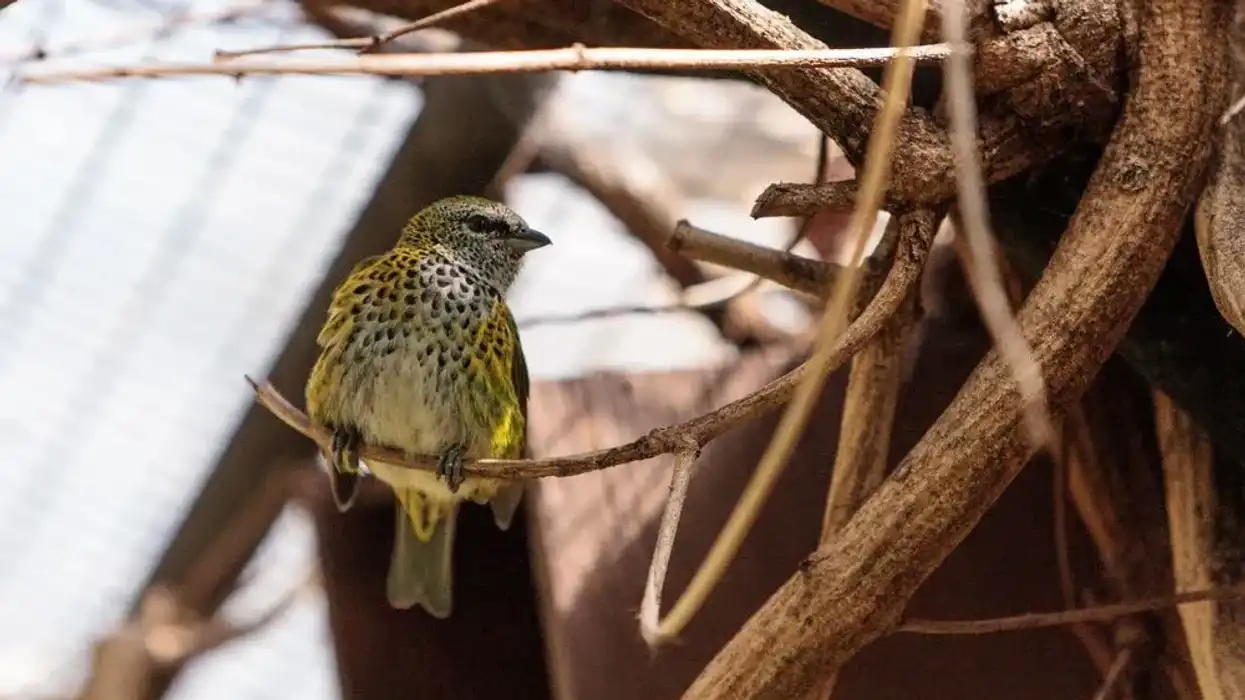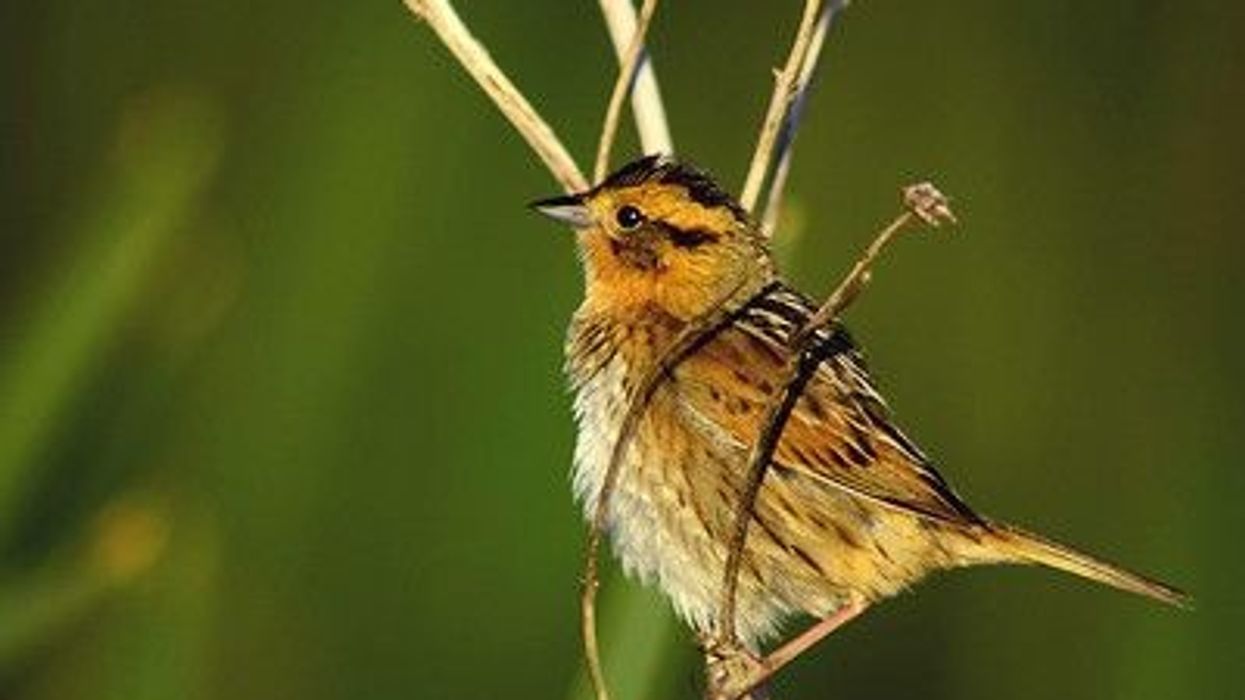The spotted tanager, Ixothraupis punctata is also commonly known as Tangara punctata. This is a subtropical bird found in parts of South America. Their habitat range focuses around Brazil, Venezuela, Peru, Bolivia, and Ecuador.
These birds live in the montane forest or savannahs. They also prefer to live in trees with studded clearings or in moist lowlands.
This bird species is known for its distinctive appearance and its melodious call. Distinctive appearance includes a greenish-blue body with black-colored spots all over. The melodious flight call is a weak sound composed with the phrases of 'tsik-tsik'.
These are medium or small-sized birds with a 4.3-4.7 in (11-12 cm) size range. Their upperparts are green-yellow and lower parts are usually bluish-creamy in color.
These birds have thin gray feet with a strong grasp. They have a quick flight and a weak flight call that they use to let their partner know about their presence during the breeding period.
Even though these birds look pretty, they are rarely kept as in-house pets. Instead, one can try and attract these tanager birds in their backyard as they fly in search of food.
For insights on similar birds check turquoise tanager and scarlet tanager.
Spotted Tanager Interesting Facts
What type of animal is a spotted tanager?
Tangara punctata are birds that belong to the Thraupidae family, genus Ixothraupis of animals found in a few specific regions of South America.
What class of animal does a spotted tanager belong to?
The spotted tanager birds belong to the Aves class of animals, just like all the other bird species across the world.
How many spotted tanagers are there in the world?
The spotted tanager size of this subtropical species of Tangara punctata is unknown. Although, the reports have recorded a considerable decrease in their habitat range due to habitat loss.
Where does a spotted tanager live?
The spotted tanagers have an extensive range of their population living in the forest areas of South America, north of Brazil, Venezuela, across the regions of Peru, Ecuador, Bolivia, and French Guiana.
What is a spotted tanager's habitat?
The spotted tanager habitat is found in the shaded plantation forest, savannahs, and tropical moist lowland areas. The average size of this bird species also lives in the trees with studded clearings and in the montane forest too.
Who does spotted tanager live with?
This species of tanager bird generally occurs solo, in its pair, or in a small group of two to a maximum of four birds together.
How long does a spotted tanager live?
Tanagers have a good lifespan as compared to the other small and medium-sized birds. The average lifespan of all the subspecies of the tanager bird ranges around 12 long years.
How do they reproduce?
The bird species of spotted tanager, Tangara punctata, are monogamous in nature. Their pair occurs together mainly during the breeding season.
Before the breeding process, these birds build a small cup nest in the trees. They use dry grass, twigs, and leaves to construct this small cup-shaped nest to lay their eggs. After the female and male mating process is completed, the female lays two to four whitish eggs.
In this pair, the female bird is known to incubate the eggs alone. The incubation process continues for a span of 13-15 days.
After the eggs hatch, the newborn nestlings are looked after and cared for by both parents. The fledging process continues, and the young ones leave the nest after a span of more than 15 days.
What is their conservation status?
This bird species of subtropical spotted tanagers, Tangara punctata, are of the Least Concern category. The International Union records this data for Conservation of Nature (IUCN) under their Red List.
Spotted Tanager Fun Facts
What does spotted tanager look like?
As the name suggests, this tanager bird has a few black spots or patterns on its body. The physical description of this tanager subspecies is alike in males and females. The upper parts of these birds are usually green and yellow in color. This part then merges with the blue-gray underparts of the bird.
The bird species of this family have conspicuous black patterns or spots all over their body. The females have a comparatively light-colored body, and this description can be helpful for onlookers to distinguish the birds based on sex.
Another distinguishing factor can be the head size and structure wherein males have a flatter head than females who have a little round in shape.
How cute are they?
This bird from South America is adorable, just like a bee hummingbird. The black spots on its body make the bird look even more fascinating.
How do they communicate?
This species of birds communicate with their vocal calls. Their flight call is weak with the sounds of 'tsik-tsik' that it uses while flying, letting the bird's pair know its presence, especially during the breeding season.
How big is a spotted tanager?
The spotted Tanager, the Tangara punctata bird, has a size range of 5.1-5.5 in (13-14 cm). They are larger than the hummingbird species.
How fast can a spotted tanager move?
This small bird species moves with rapid wing movements. These birds can move and fly at a speed of 31 mph (50 kph).
How much does a spotted tanager weigh?
The Tangara punctata is a medium-sized bird with a weight range of 0.4-0.5 oz (13-17 g).
What are the male and female names of the species?
Spotted Tanager, Tangara punctate is a sex-neutral term used for all of these bird species. Although, these birds can be distinguished based on their appearance. For instance, the male birds have a flatter head and brighter body whereas females have a round head and duller body than males.
What would you call a baby spotted tanager?
Females lay around 2-4 eggs during one mating season. After hatching, these Tangara punctata babies are called nestlings, or hatchlings, just like the other bird babies.
What do they eat?
Spotted tanager birds have an omnivorous diet. Their diet includes mealworms, insects, bees, beetles, other small black worms, and their larvae. Apart from this, their diet also incorporates seeds, all kinds of berries, fruits, and flower nectar.
While hunting for bees, wasps, or other poisonous small insects, these birds choose the spots against a branch to hunt the insects so that they can remove the stingers before consuming the insect. A few of these bird species namely the Scarlet tanager was known to reduce the caterpillar and moth quantities in their vicinity.
This was assumed mainly because they were known to feed on 2000 gypsy moths in just an hour or 600 caterpillars within a span of just 15 minutes.
Are they poisonous?
No, there are no reports of these birds being poisonous for humans or other animals. Although they feed on fruits and seeds, many farm landowners may think of them as pests.
Would they make a good pet?
The punctata species of birds are wild animal, and keeping them as pets is quite rare. Although in case anyone wants to keep these birds as pets, one needs to be extra cautious about their diet, environmental description, and other required needs.
These might be a few reasons why tanagers do not make good pets even if they look the cutest.
Even though humans may not have petted tanagers before, these birds are often seen in human settlements especially in the backyards and urban gardens. They come around these settlements in search of food.
This food search may vary from insects to flowers to even the bird feeders kept in the yards. Hence, seeing a spotter tanager, Tangara punctata or any other tanager species is not a rare phenomenon.
Did you know...
There are five different subspecies of the Tangara punctata found in Venezuela, north Peru, central Peru, south Peru, and west-central Bolivia respectively. Even though a maximum number of these Tangara species birds are of most minor concern, a few of these birds are considered rare.
For instance, the summer tanager and the flame-colored tanager are two of the many tanager birds that are considered rare in some parts of America.
Even though all the species of the tanager birds are colorful and small, the bill shape and size of every subspecies differs based on the dietary intake they engage in.
Why is it called a spotted tanager?
Every tanager bird has its name specified based on its appearance. The name Tangara punctata is the Latin term used for this bird. The word punctata in Latin means spotted. This is used for this bird due to the black patterns that look like spots all over its body.
How are they different from other tanagers?
There are different species and subspecies of the Tangara or tanager birds. They are an eastern or western Tangara/tanager, a speckled tanager, scarlet Tanager, emerald tanager, flame-crested Tanager, summer tanager, and many more.
The difference between these species of tanagers and the spotted or Tangara punctata can be considered - their location or areas of occurrences, their habitat requirements, and mainly their physical descriptions. Most of these birds get their name based on their descriptions. Hence, it gets easier to discriminate and identify this species of the Thraupidae family.
Here at Kidadl, we have carefully created lots of interesting family-friendly animal facts for everyone to discover! For more relatable content, check out these golden hooded tanager facts and tanager facts for kids.
You can even occupy yourself at home by coloring in one of our free printable bird coloring page









